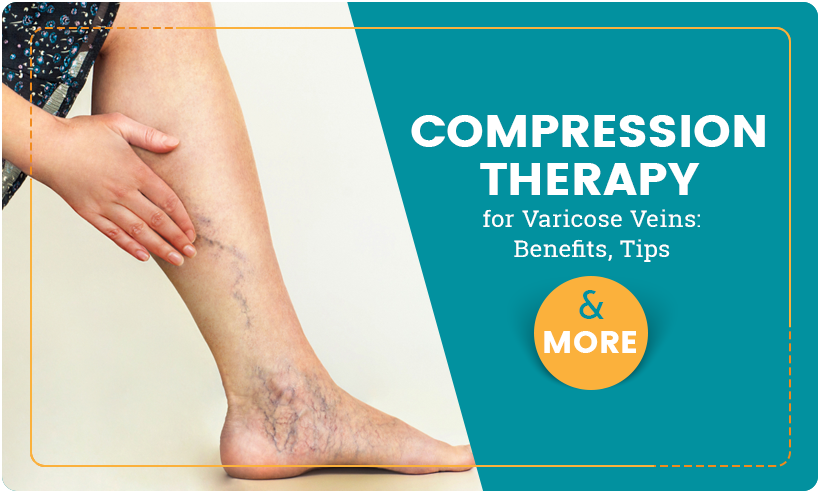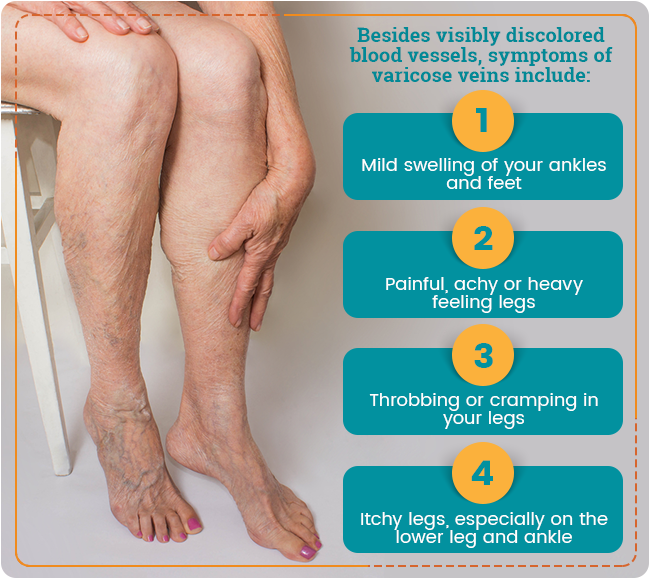
Compression Therapy for Varicose Veins: Benefits, Tips and More
You’ve noticed dark, swollen, unsightly veins forming in your lower legs, and you suspect that you might have varicose veins. You’ve heard that compression stockings can prevent their appearance or manage symptoms if you’ve already got varicose veins—but you haven’t worn compression garments before and don’t want to start.
To help you out, we’ve put together the ultimate guide on compression therapy for varicose veins. Below, we’ll explain what varicose veins are, as well as causes and risk factors for developing them. Then we’ll explain when it’s a good idea to wear compression stockings for varicose veins and offer shopping and donning tips to help you choose the right pair.
What Are Varicose Veins?
If you have blue, twisted veins close to the surface of your skin that are swollen and uncomfortable, you probably have varicose veins. While these veins can occur in any part of your body, they’re most commonly found in the legs.
Spider veins are smaller than varicose veins, and they’re usually located right next to the surface of the skin. (Varicose veins may or may not be located close to the surface.) Spider veins are usually red or purple in color and often look like spider web tendrils—hence the name. Spider veins usually appear on the legs or the face. They’re caused by the same mechanism as varicose veins, but they don’t usually bulge out from the skin the way varicose veins do. Spider veins during pregnancy are especially common.
Besides the clearly visible signs of discolored, swollen blood vessels, other symptoms of varicose veins include:
- Mild swelling of your ankles and feet
- Painful, achy or heavy feeling legs
- Throbbing or cramping in your legs
- Itchy legs, especially on the lower leg and ankle (may be diagnosed as dry skin)

While varicose veins and spider veins may look unsightly, they don’t often lead to serious health problems as long as they’re well managed. Varicose veins can also lead to a condition called superficial thrombophlebitis, which occurs when blood clots form in a vein close to the surface of the skin. This clot may result in swelling, pain and tenderness.
Even if varicose and spider veins don’t result in further complications on their own, these inflamed veins do signal compromised circulation that can contribute to many different health problems down the road. If you have varicose or spider veins, don’t ignore them. Instead, talk to your doctor about what lifestyle changes you can make to promote better circulation.
What Causes Varicose Veins?
Varicose veins are often a result of chronic venous insufficiency, which occurs when the veins of the legs have difficulty returning blood to the heart. As for what chronic venous insufficiency means, the valves in your veins control the flow of blood and, when they’re working properly, they only allow the blood to flow one way.

However, if the valves are compromised through excess pressure, the flaps can malfunction and let the blood pool in place or even flow the wrong way. This causes the veins to become enlarged with excess blood, resulting in the swollen, twisted appearance that is the hallmark of varicose veins.
Chronic venous insufficiency and varicose veins don’t arise spontaneously on their own. The following factors often contribute to developing varicose veins:
- Sitting or standing for long periods of time
- A blood clot in a deep vein, usually in the lower legs (deep vein thrombosis)
- Swelling and inflammation of a vein
- Trauma to the leg due to surgery, injury or previous blood clots
- Family history of venous insufficiency and varicose veins
- Gender (women are more likely to develop varicose veins than men)
- Pregnancy (the growing fetus puts pressure on the veins in the lower legs)
- Age (normal wear and tear over the years can weaken blood vessel valves)
- Overweight or obesity (excess weight puts added pressure on your veins)
- Lack of exercise
- Smoking
If you have a combination of these risk factors, talk to your doctors about how you can maintain your venous health and prevent future problems like varicose veins from developing.
When to Use Compression Therapy for Varicose Veins
Graduated compression socks can help manage varicose vein symptoms. Compression socks provide graduated pressure that’s greater at the ankle than at the top of the sock in order to promote proper blood flow and help decrease swelling.

Compression therapy for varicose veins helps to provide gentle pressure on the blood vessels, discouraging blood from pooling and contributing to proper one-way blood flow. Compression stockings can also help manage swelling, especially if you don the compression stockings first thing in the morning before the swelling can start. The tight fabric won’t allow the veins to expand like they normally would, reducing swelling.
Through a combination of these effects, compression stockings for varicose veins can help manage painful, aching legs as well as throbbing and cramping. However, you should talk to your doctor before wearing compression stockings to make sure that you don’t have any other conditions that might compromise the effectiveness of the stockings or result in unintended side effects.
If you already have varicose veins, compression stockings can help relieve some of the symptoms and smooth the appearance. If you want to wear compression stockings, 15-20 mmHg (moderate) compression are a recommended compression level without the need for a prescription, but consult your doctor for higher levels of compression such as 20-30 mmHg (firm), 30-40 mmHg (extra firm) or even 40-50 mmHg (Rx) . These levels may only be available with a doctor’s prescription, which is another reason you’ll want to discuss wearing these garments with your doctor.

How to Choose Compression Stockings for Varicose Veins
Once you’ve cleared compression stockings with your doctor, and they’ve recommended the correct level of compression for you, it’s time to shop for compression therapy hosiery. Here’s how to shop for and wear compression stockings for varicose veins:
Choose your length.
Most varicose veins manifest in the lower body, so we’re going to focus our shopping guide on that. The location(s) of the veins will influence what type of compression garment you choose. For example, if you only have varicose veins in your calves, then you might want to look at knee-high compression socks. If you have them in your thighs and upper legs, then thigh-high stockings might be a better choice. If you want even more coverage, compression pantyhose or waist-highs will fit the bill.
Find your size.
Once you’ve chosen your style of compression garment, it’s time to measure yourself and find your size. Depending on what style you select, you might need to measure the circumference and/or length of your ankle, calf and/or thigh. Compare those measurements to the size chart to find your size. Double check the sizing chart for each brand, as sizes can vary from company to company. Choosing the right size of compression garment is important: If it’s too small or too loose, it won’t provide the right level of compression that you need.
Select your style.
Now it’s time for the fun part: choosing your style! Beyond just socks vs. thigh highs vs. stockings, there are several choices to be made. First of all, you’ll need to decide between opaque or sheer fabric or if you’d prefer patterned socks. There are also four toe styles to choose from: closed toe, open toe, inspection toe and footless. You’ll also need to choose a color, which varies from product to product. Basic neutrals such as black, beige and white are almost always available, and certain lengths such as socks also come in many bold solid colors as well as fun patterns.

Learn a proper donning technique.
Okay, so now your compression gear has arrived, and it’s time to try them on to make sure you made the right choice. Compression isn’t quite like putting on regular socks or pantyhose due to the special material and tight weave.
To properly don compression garments, start by turning the stocking inside out (the “heel pocket” method). To do this, put your hand inside the stocking, grasping the heel and pulling it inside out. Slide your foot into the “pocket” so that your toes are positioned correctly, then pull the stocking up and over your foot to position heel correctly.
Finally, pull the sock or stocking the rest of the way up your leg, smoothing the wrinkles as you go. Here’s a video that demonstrates this heel pocket method.
Watch out for bad methods.
If you wear a ring, it’s a good idea to take it off before donning or removing compression gear to avoid snagging the fabric. If you use any cream or lotion, make sure it has dried thoroughly before donning the compression garments. And don’t just pull the top band to put the stockings on, as this can damage the fabric. Instead, gently roll the fabric up the leg and carefully smooth out any wrinkles. If you’re wearing knee-high stockings, make sure that the band doesn’t buckle behind the knee, as this can cut off circulation. Finally, never fold over your compression hose—this can cause reverse compression!
Look into donning aids.
If you struggle to put on compression stockings for varicose veins, don’t fret! Many people have trouble donning compression garments, especially if they haven’t worn them before. There are several different strategies you can try to make donning easier on yourself.

Baby powder or talc may help stockings glide over your skin. Rubber gloves make it easier to get a grip on the material, move the fabric up your legs and smooth out bumps and wrinkles. If you have limited mobility, it might be worthwhile to invest in a stocking donner. These devices are made from sturdy coated metal wire and hold the stocking in place and partially open. This makes it easier to insert your foot into the stocking and properly position it.
Consider wraps if necessary.
If you’re still struggling to put on compression stockings even with donning aids, you might want to look into compression wraps. These garments are made from thick, durable material that wraps around the affected limb and secures in place with hook and loop. Compression wraps can be adjusted to give different levels of compression, making them very versatile garments. However, you have to properly measure their compression level each time you secure the hook and loop straps to ensure that they’re neither too tight nor too loose.
Most people are able to wear compression stockings for varicose veins without any side effects, but you should talk to your doctor if you see redness or open skin on your feet or legs, or if you experience any increased pain, swelling or numbness while wearing compression hose. If you’re tempted to discontinue wearing compression hose because they are uncomfortable, talk to your doctor first—you might need a different type or size.
Compression therapy can’t cure varicose veins, but it can help manage your symptoms and help improve your circulation and your overall quality of life. If you’re already at risk for developing varicose veins based on the criteria we reviewed above, you might want to consult with a doctor and wear mild or medium compression stockings as a preventive measure to preserve your vein health. Combined with lifestyle changes, compression stockings can help make a difference for the better in your lower body circulation.
Kaki Zell - Vice President of Sales, Marketing, eCommerce at Legs-4-Life LLC Kaki holds a Bachelor of Science degree in Business Administration and Management from Virginia Polytechnic Institute and State University. She’s been working in the medical device industry for over 11 years and currently serves on the Board of Directors for the Greensboro Science Center.
Written May 2019 | Page last updated November 2021
Sources:
National Heart, Lung, and Blood Institute. “Varicose Veins” https://www.nhlbi.nih.gov/health-topics/varicose-veins
Cleveland Clinic. “Superficial Thrombophlebitis” https://my.clevelandclinic.org/health/diseases/17523-superficial-thrombophlebitis
Medline Plus. “Venous Insufficiency” https://medlineplus.gov/ency/article/000203.htm
Mayo Clinic. “Varicose Veins” https://www.mayoclinic.org/diseases-conditions/varicose-veins/symptoms-causes/syc-20350643